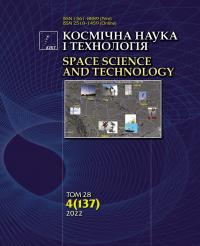Потенціал сили тяжіння та його складова відцентрової сили всередині еліпсоїдальної планети
DOI:
https://doi.org/10.15407/knit2022.04.071Ключові слова:
відцентрова сила, еліпсоїд, концепція гравітаційних дисків, потенціал, сила тяжінняАнотація
Запропонована методика визначення потенціалу притягання небесного тіла, поверхня якого є сферою чи еліпсоїдом зі стрибкоподібною функцією розподілу мас. Для цих випадків отримано формули для визначення внутрішнього потенціалу та сили тяжіння. Виконані за цими формулами обчислення дають змогу зробити аналіз вкладу еліптичності планети в значення її внутрішнього потенціалу та порівняти його з величиною відцентрової сили для планет земної групи (Земля, Марс, Венера) та Місяця.
Посилання
Kamensky K. K. (1982). Study of the global features of the level and hypsometric surfaces of Venus. Study of the Earth as a planet by methods of astronomy, geodesy and geophysics: Tr. II Orlov Conf. Kyiv: Naukova Dumka, 80-83.
Moritz H. (1994). The Figure of the Earth: Theoretical Geodesy and the Internal Structure of the Earth. Kyiv, 240 p.
Fys M. M., Holubinka Y. I., Yurkiv M. I. (2014). Comparative analysis of formulas for the potential and its radial derivatives of three-layer spherical and ellipsoidal planets. Modern achievements of geodetic science and production, I (27), 46--52.
Fys M. M., Zayats O. S., Foca R. S., Volos V. O. (2005). On a method for determining the potential of an inhomogeneous ellipsoidal planet. Modern achievements of geodetic science and production, 236-239.
Fys M. M., Nikulishyn V. I. (2011). Analysis of the influence of the ellipsoidality of the Earth's figure on its internal structure on the example of the PREM model. Geodynamics, № 1 (10), 17-21.
https://doi.org/10.23939/jgd2011.01.017
Fys M. M., Sohor A. R., Nikulishyn V. I. (2013). Potential and its radial derivatives of three-layered spherical planets. Geoinformation Monitoring of the Environment: GNSS and GIS - Technologies: Proc. Int. Sci. and Tech. Symp. Alushta, p. 229-233.
Tserklevych A. L., Zayats O. S., Fys M. M. (2012). Gravitational models of three-dimensional distribution of the density of the planets of the terrestrial group. Geodynamics, № 1 (12), 25-34.
https://doi.org/10.23939/jgd2012.01.042
Dolifus A. (1972). New optical measurements of planetary diameters. P. 4. Planet Mars. Icarus, 17, № 3, 525-539.
https://doi.org/10.1016/0019-1035(72)90016-4
Fys M. M, Brydun A. M.,Yurkiv M. I. (2019). On representation of the internal spherical functions and their derivatives in the planetary coordinate system. Mathematical modeling and computing, 6, № 2, 251-257.
https://doi.org/10.23939/mmc2019.02.251
Fys M. M, Brydun A. M., Yurkiv M. I. (2021) On approach to determine the internal potential and gravitational energy of ellipsoid. Mathematical modeling and computing, 8, № 3, 359-367.
https://doi.org/10.23939/mmc2021.03.359
Marchenko A. N., Zayats A. S. (2008) Estimation of the potential gravitational energy of the Earth based on reference density models. Geodynamics, № 1 (7), 5-24.


